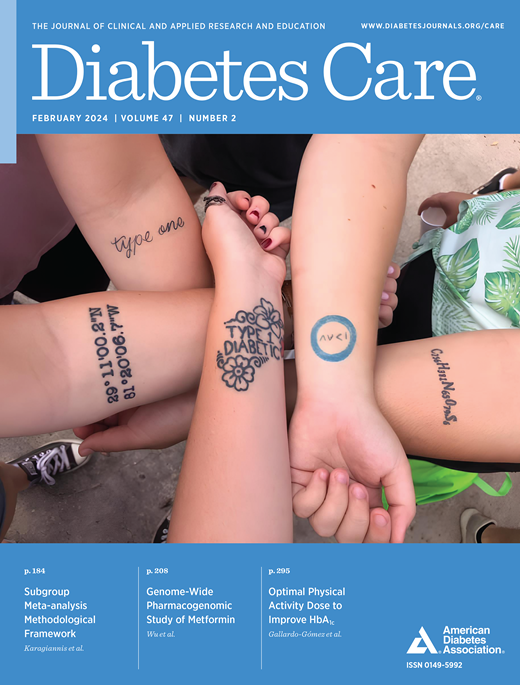Effects of Continuous Glucose Monitoring on Impaired Awareness of Hypoglycemia in Older Adults With Type 1 Diabetes: A Post Hoc Analysis of the WISDM Study
IF 16.6
1区 医学
Q1 ENDOCRINOLOGY & METABOLISM
引用次数: 0
Abstract
OBJECTIVE Although continuous glucose monitoring (CGM) reduces hypoglycemia and may improve impaired awareness of hypoglycemia (IAH), its effectiveness in older adults at high risk remains unknown. RESEARCH DESIGN AND METHODS This post hoc analysis of the WISDM study focuses on CGM use over 52 weeks. IAH was assessed using the Clarke original score (Clarke-full) and its subscales, Hypoglycemia Awareness Factor (HAF) and Severe Hypoglycemia Experienced Factors (SHEF), at baseline, 26 weeks, and 52 weeks. RESULTS After 26 (n = 184) and 52 weeks (n = 94) of CGM use, Clarke-SHEF decreased significantly (P = 0.02 and P < 0.0001, respectively), whereas Clarke-full and Clarke-HAF remained unchanged. After 52 weeks, Clarke-full but not Clarke-HAF improved in the IAH subgroup, highlighting the importance of selecting the appropriate scoring method for IAH. CONCLUSIONS In older adults with type 1 diabetes, CGM improves hypoglycemia; however, its role in improving IAH is variable, depending on the scoring method. This study highlights the limitations of the Clarke score.连续血糖监测对老年1型糖尿病患者低血糖认知受损的影响:WISDM研究的事后分析
目的:尽管持续血糖监测(CGM)可降低低血糖,并可改善低血糖认知受损(IAH),但其在高危老年人中的有效性尚不清楚。研究设计和方法对WISDM研究的事后分析侧重于使用CGM超过52周。在基线、26周和52周时,采用Clarke原始评分(Clarke-full)及其亚量表低血糖意识因子(HAF)和严重低血糖经历因子(SHEF)对IAH进行评估。结果使用CGM 26周(n = 184)和52周(n = 94)后,Clarke-SHEF显著降低(P = 0.02和P &;lt; 0.0001),而Clarke-full和Clarke-HAF保持不变。52周后,IAH亚组的Clarke-full改善,而Clarke-HAF没有改善,这突出了选择合适的IAH评分方法的重要性。结论:在老年1型糖尿病患者中,CGM可改善低血糖;然而,它在改善IAH中的作用是可变的,取决于评分方法。这项研究突出了克拉克评分的局限性。
本文章由计算机程序翻译,如有差异,请以英文原文为准。
求助全文
约1分钟内获得全文
求助全文
来源期刊

Diabetes Care
医学-内分泌学与代谢
CiteScore
27.80
自引率
4.90%
发文量
449
审稿时长
1 months
期刊介绍:
The journal's overarching mission can be captured by the simple word "Care," reflecting its commitment to enhancing patient well-being. Diabetes Care aims to support better patient care by addressing the comprehensive needs of healthcare professionals dedicated to managing diabetes.
Diabetes Care serves as a valuable resource for healthcare practitioners, aiming to advance knowledge, foster research, and improve diabetes management. The journal publishes original research across various categories, including Clinical Care, Education, Nutrition, Psychosocial Research, Epidemiology, Health Services Research, Emerging Treatments and Technologies, Pathophysiology, Complications, and Cardiovascular and Metabolic Risk. Additionally, Diabetes Care features ADA statements, consensus reports, review articles, letters to the editor, and health/medical news, appealing to a diverse audience of physicians, researchers, psychologists, educators, and other healthcare professionals.
 求助内容:
求助内容: 应助结果提醒方式:
应助结果提醒方式:


